For many years, the Culroy Burn in the Middle Doon catchment has been under producing in terms of fish production, particularly salmon. It has been repeatedly stocked by the Board whenever they have reared eggs in the hatchery and released them into the river to grow on to hopefully return as spawning adults however, the relatively poor survey results we found indicated that either natural spawning success was poor and/or the stocked fish didn’t survive to reproduce. In 2013 we completed an egg survival trial and both sample egg boxes situated in this burn over winter failed to produce fry. There could be several reasons for this and we can’t rule out handling error but this seems unlikely. We believe that environmental factors led to these losses.
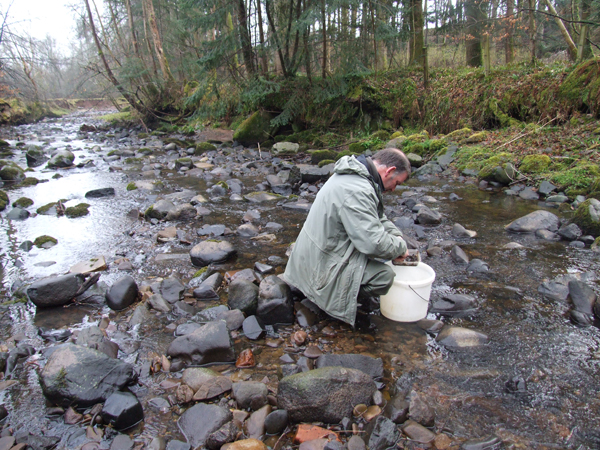
Egg box trials in 2012/13
We haven’t conclusively answered the question of why this burn is under producing, however at best we suspected a combination of poor egg survival, stocking failure and low marine survival are responsible. Pinpointing the loss is difficult particularly when naturally produced wild salmon are also struggling to survive the marine phase of their lifecycle.
With the Board’s approval and financial support, we decided to tackle some of the issues we knew existed in this burn. The main problem we could see was that the habitat was suffering from very high silt levels and this we believed, compromised natural recruitment and degraded the habitat for any surviving juveniles. Addressing silt inputs required landowner support and this was achieved by offering grants of up to 50% towards the cost on installation (provided by the Doon DSFB). There weren’t any better grants available for fencing anywhere. Blackbyres landowners jumped at the offer of assistance as they had been losing land for some time and there was no end to this in sight. Eventually, the burn was destined to cut straight across his field without drastic intervention. Fencing alone wasn’t going to stop this erosion hot spot and ART developed a plan to re grade the eroding bank to make it more able to withstand spates. Additional reinforcement was provided by installing a stretch of willow spiling followed by stock proof fencing once work was completed. SEPA approved the project and work commenced in July 2015.
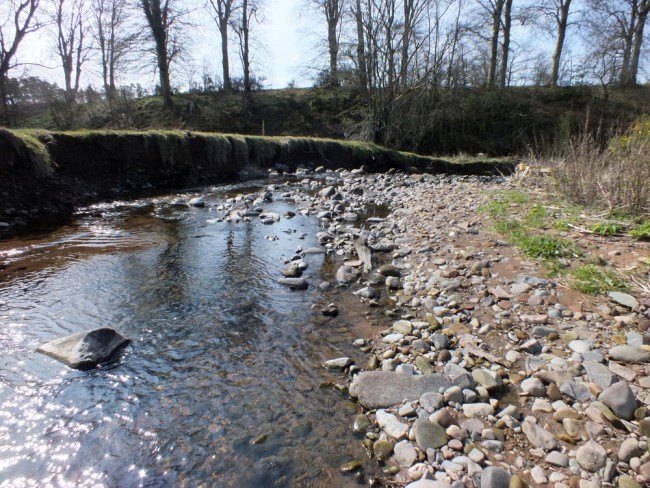
Severe and accelerated erosion on the Culroy Burn before we commenced work to regrade and stabilise this bank
The bank was re profiled and then re-turfed using sods stripped from the site. The toe of the bank had willow spiling installed along the upper section to create a living revetment. Finally a high quality stock proof fence was erected. During the works, ART installed a couple of upstream facing large woody deflectors to help turn the force of the water from the bank during spates. A few native trees were planted and all looked good. We stood back and admired the job and all involved were pleased with the results including the DSFB who funded our work. Then came the torrential rain and wild weather at the tail end of Hurricane Abigail that hit the UK on the 12th and 13th November 2015.
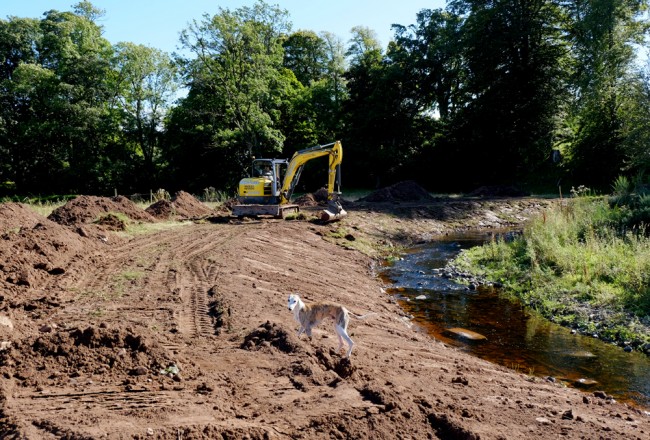
Re profiling the bank
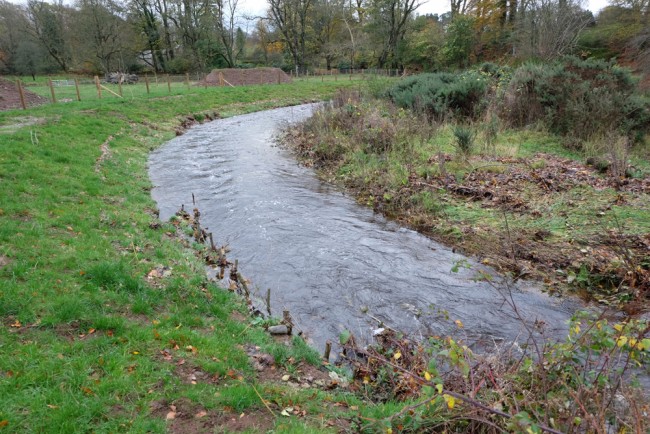
Just over 2 months after completion and all looked promising at this time during a decent sized spate
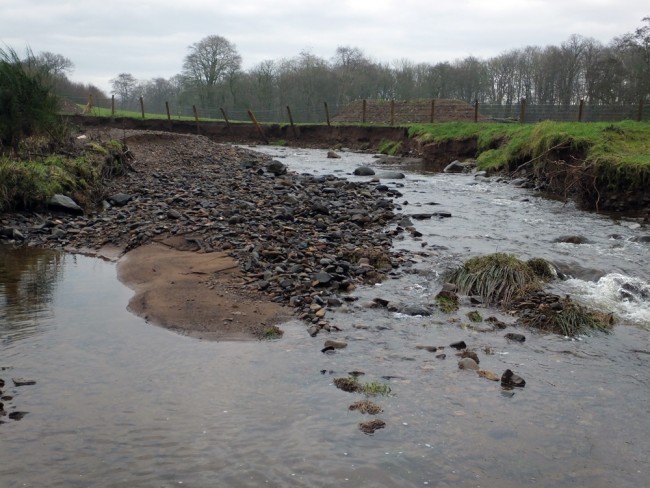
The aftermath of Hurricane Abigail. A large section of the re graded bank had been washed away in a huge spate leaving the new fence hanging. The river overtopped the banking in this flood
The spate washed away, roads, flooded Minnishant downstream which must have been terrible for those affected but worst of all (in our eyes and for us only) destroyed the hard work we had put into regrading the bank. It ripped out the log deflectors in the process. We believe a large tree was carried down the burn and burst a hole in the green bank engineering. This allowed the spate to erode tonnes of soil from the bank we had so carefully restored and left out newly erected fence hanging in mid air. What a disaster! It was back to the drawing board with a few lessons learned.
We decided to reinstate the bank and repair the fencing but this time we would use a man made geo textile and grass seed to quickly stabilise the repaired slope as we didn’t believe the turf had knitted well. Essentially, we had to perform the machine works early in the year to ensure the bank was well established before winter. This turned out to be a problem as we couldn’t hire a machine and driver anywhere at the time we needed to do this. The job was delayed and delayed again however, the Trust staff were determined to reinstate the willow spiling and set about this in July and August, extending it downstream and strengthening the whole bank considerably. The plan was to backfill it later when a tracked machine became available. By September we realised there was no way that grass seed would develop quickly enough to strengthen the bank before winter 2016 and reluctantly we postponed further work until 2017. We kept our fingers crossed for a dry winter with small spates. For once we were fortunate.
Earlier this year (June 2017), the bank was finally regraded and grass seed sown over a geo textile membrane. Additional willow was added as again winter spates had done some damage to the unsupported weaving but nothing serious. This was to be expected and we were really quite impressed how little damage had been done. With the bank reinstated, the fence was repaired and again we waited to see the results. The images below show progress over this summer and we are confident that this bank will stand up to whatever the burn throws at it now. Time will tell.
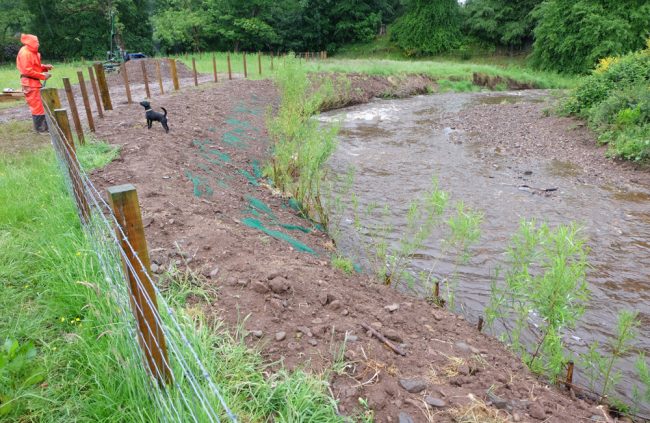
Fence and bank repaired in June 2017. The grass seed germinated quickly and we even planted a few trees in the very wet conditions that prevailed. They survived and are doing well
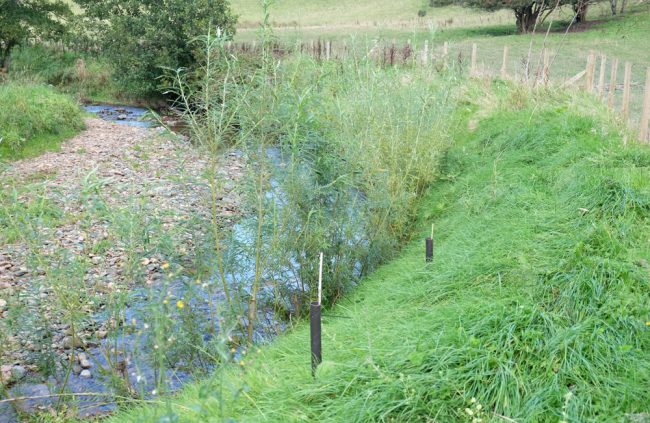
A different angle that shows just how well the bank and willow spiling were doing by September 2017. Is it too early to breath a sigh of relief?
Hurricane Abigail did do us some favours though. The weir at Minnishant (about 1 mile downstream) that had stood the test of time for over 150 years was breached. The huge spate of the 13th November took 4 or 5 mature Lime and Ash trees with it as it ripped past the top end of the weir and cut a bypass channel around it. Some of these trees lodged downstream at the A77 road bridge causing a major flood in Minnishant. Houses and businesses in the village were about 3′ underwater. Once the floods subsided and the damage repaired, we couldn’t help but be pleased to see the weir buried under tonnes of sediment deposited by the river during the spate. The new channel was suitable for fish migration so no more did we have to be concerned over the impact this weir was having on trout and salmon migrating at spawning time. The spate also carried with it tonnes of fine sediments that had built up in the burn particularly upstream of the weir. Habitat was scoured clean (well almost) and we could see where things would improve with time. This summers constant high water and our fencing upstream has led to a substantial reduction in silt loading.
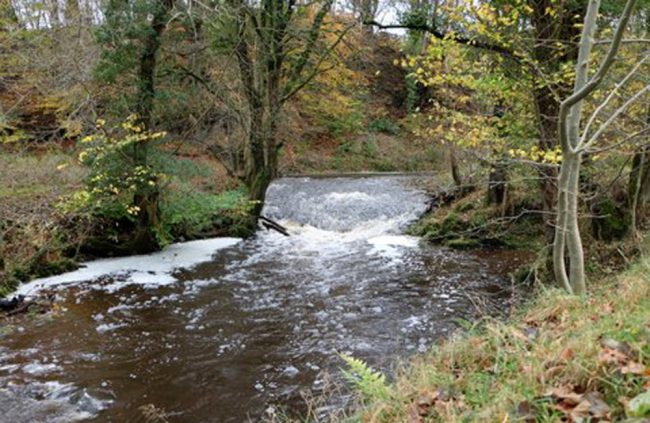
The weir prior to Hurricane Abigail November 2015 An obstacle but not a total barrier to migration
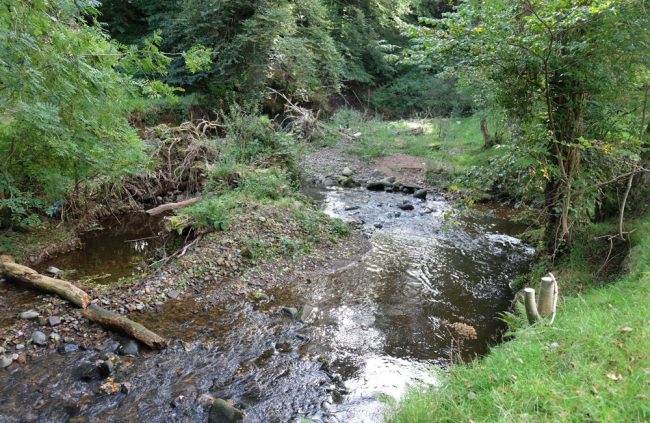
The weir today. The burn flows around the structure that is now largely buried under tonnes of sediment. It’s a shame someone cut that wee ash tree down.
That’s not quite the end of the story of improvements on this burn. After over 2 years of hitting a brick wall, eventually we managed to secure agreements with the landowners at Knockdon to fence a field at Sauchrie in the upper reaches. This section of the burn had multiple issues affecting it but in particular, livestock grazing and access that led to erosion and the addition of fine sediments, again impacting on spawning. The burn was over wide as a result of continual over grazing and bank erosion and in dry summer months, was prone to losing all it’s flow as the water percolated through coarser substrates that had been deposited in low energy areas. An ancient weir compounded the problems and interrupted sediment transport downstream. There was also a collapsed bridge at the top of the stretch that caused bank erosion and this was removed too.
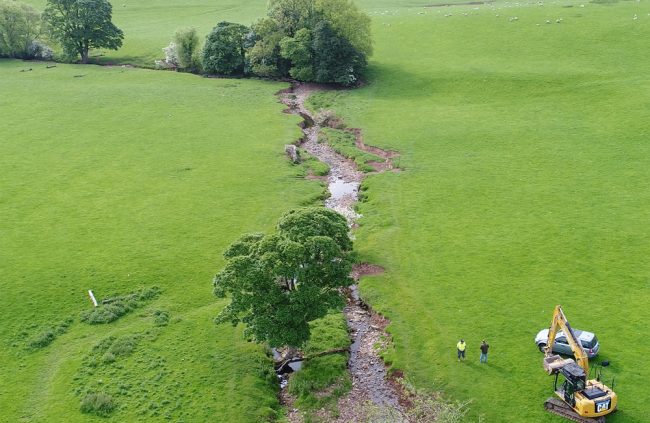
About to start and the problems are obvious
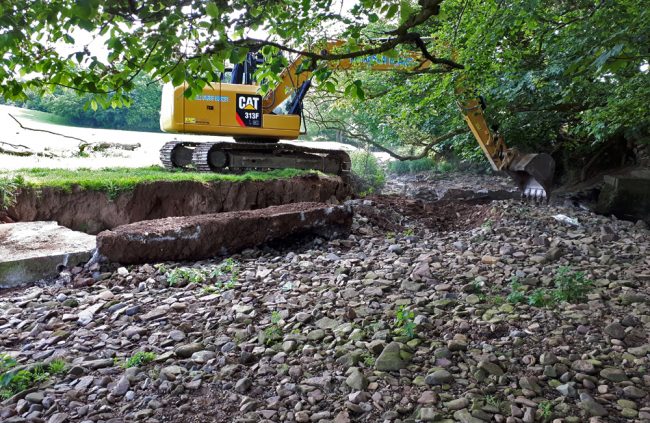
Removing a small and redundant weir that was partially collapsed when we started this work. Note that there was no water flowing at this time. The burn was over wide and lacked energy to transport coarser sediments. The weir also trapped fine sediment that choked the gaps between the larger stones
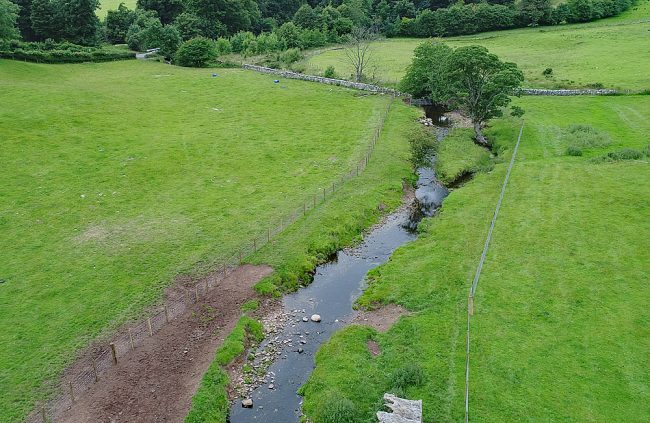
Looking upstream towards Sauchrie. Fencing has been erected. The bare soil was caused by livestock eroding the margins. This was seeded to assist rapid recovery. We levelled this ground with the excavator to allow a straighter fence to be erected. Fish habitat has and will continue to improve as the fine silt clears downstream and the burn narrows
This year we removed the weir and bridge with SEPA’s consent and fenced the burn on both banks for over 300m. We regraded erosion scars away from the water’s edge where sheep and cattle had rubbed and lain for shelter to allow a better fence to be erected. Almost as soon as the work was completed, the weather broke and we’ve watched spate after spate transform the burn within this site all summer long. Upstream of the weir, the bed has cut down by over 50cm taking with it fine sediments that were trapped for years. Runs and riffles have developed, moved, disappeared and returned all in a few short months as the river adjusted to it’s preferred levels. This may continue for some time. The banks have grown lush and the grass seed we sowed over bare areas is thick and offers protection from further erosion. Faecal matter that coated the bed of this burn has ceased following the exclusion of livestock so nutrient and bacteria levels will have dropped along with an obvious reduction in fine sediment loading which will continue to reduce as the banks re vegetate. Overall, the quality of the habitat for fish has improved dramatically and we expect so too has water quality. Trees have been planted and more will go in this winter to offer shade and help improve the habitat in years to come.
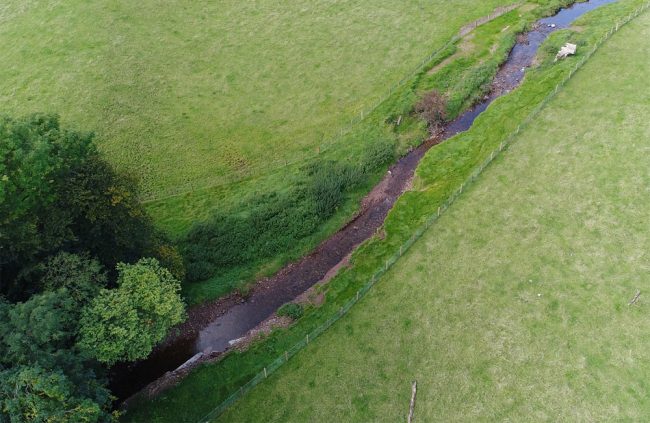
Things are improving and its only been a few months since this work was completed. The burn has cleared much of the fine sediment already and there narrowing occurring in places. This will continue to improve with time
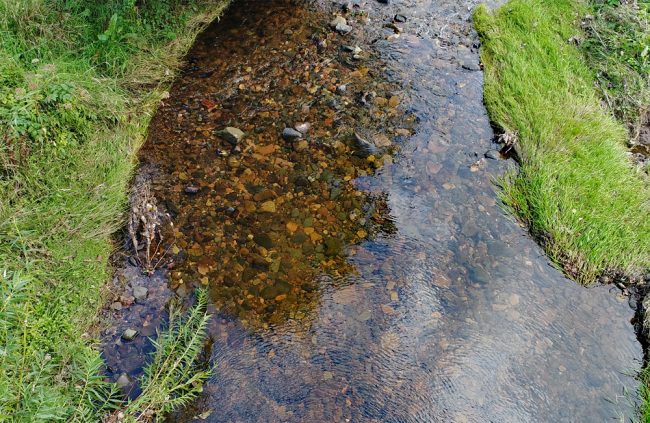
A major achievement for a burn that was heavily impacted by silt….clean substrates for spawning.
We hope to be able to report encouraging results when we survey these areas next year after a spawning season has passed but we are concerned that the very poor runs of salmon entering the Doon system at the moment may not reach this habitat in great numbers soon. Time will tell but we know we have done our best to make this happen. If the Scottish Government were to be as concerned about marine survival of wild salmon as we are with improving fresh water habitats and potential for spawning, then we may yet see a return to the glory days of the salmon in Ayrshire…


Great article and top work.
Thanks for your support, Gavin.